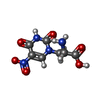Entry Database : PDB / ID : 4q30Title Nitrowillardiine bound to the ligand binding domain of GluA2 at pH 3.5 Glutamate receptor 2 CHIMERIC PROTEIN Keywords / / / / / / / Function / homology Function Domain/homology Component
/ / / / / / / / / / / / / / / / / / / / / / / / / / / / / / / / / / / / / / / / / / / / / / / / / / / / / / / / / / / / / / / / / / / / / / / / / / / / / / / / / / / / / / / / / / / / / / / / / / / / / / / / / / / / / / Biological species Rattus norvegicus (Norway rat)Method / / / Resolution : 2.03 Å Authors Ahmed, A.H. / Oswald, R.E. Journal : Biochemistry / Year : 2014Title : Thermodynamics and mechanism of the interaction of willardiine partial agonists with a glutamate receptor: implications for drug development.Authors : Martinez, M. / Ahmed, A.H. / Loh, A.P. / Oswald, R.E. History Deposition Apr 10, 2014 Deposition site / Processing site Revision 1.0 Jun 4, 2014 Provider / Type Revision 1.1 Jul 2, 2014 Group Revision 1.2 Jul 26, 2017 Group / Source and taxonomy / Category / entity_src_gen / Item Revision 1.3 Sep 20, 2023 Group Data collection / Database references ... Data collection / Database references / Derived calculations / Refinement description Category chem_comp_atom / chem_comp_bond ... chem_comp_atom / chem_comp_bond / database_2 / pdbx_initial_refinement_model / pdbx_struct_conn_angle / struct_conn / struct_ref_seq_dif / struct_site Item _database_2.pdbx_DOI / _database_2.pdbx_database_accession ... _database_2.pdbx_DOI / _database_2.pdbx_database_accession / _pdbx_struct_conn_angle.ptnr1_auth_asym_id / _pdbx_struct_conn_angle.ptnr1_auth_comp_id / _pdbx_struct_conn_angle.ptnr1_auth_seq_id / _pdbx_struct_conn_angle.ptnr1_label_asym_id / _pdbx_struct_conn_angle.ptnr1_label_atom_id / _pdbx_struct_conn_angle.ptnr1_label_comp_id / _pdbx_struct_conn_angle.ptnr1_label_seq_id / _pdbx_struct_conn_angle.ptnr2_auth_asym_id / _pdbx_struct_conn_angle.ptnr2_auth_seq_id / _pdbx_struct_conn_angle.ptnr2_label_asym_id / _pdbx_struct_conn_angle.ptnr3_auth_asym_id / _pdbx_struct_conn_angle.ptnr3_auth_comp_id / _pdbx_struct_conn_angle.ptnr3_auth_seq_id / _pdbx_struct_conn_angle.ptnr3_label_asym_id / _pdbx_struct_conn_angle.ptnr3_label_atom_id / _pdbx_struct_conn_angle.ptnr3_label_comp_id / _pdbx_struct_conn_angle.ptnr3_label_seq_id / _pdbx_struct_conn_angle.value / _struct_conn.pdbx_dist_value / _struct_conn.ptnr1_auth_asym_id / _struct_conn.ptnr1_auth_comp_id / _struct_conn.ptnr1_auth_seq_id / _struct_conn.ptnr1_label_asym_id / _struct_conn.ptnr1_label_atom_id / _struct_conn.ptnr1_label_comp_id / _struct_conn.ptnr1_label_seq_id / _struct_conn.ptnr2_auth_asym_id / _struct_conn.ptnr2_auth_comp_id / _struct_conn.ptnr2_auth_seq_id / _struct_conn.ptnr2_label_asym_id / _struct_conn.ptnr2_label_atom_id / _struct_conn.ptnr2_label_comp_id / _struct_conn.ptnr2_label_seq_id / _struct_ref_seq_dif.details / _struct_site.pdbx_auth_asym_id / _struct_site.pdbx_auth_comp_id / _struct_site.pdbx_auth_seq_id Revision 1.4 Nov 20, 2024 Group / Category / pdbx_modification_feature / Item
Show all Show less
 Yorodumi
Yorodumi Open data
Open data Basic information
Basic information Components
Components Keywords
Keywords Function and homology information
Function and homology information
 X-RAY DIFFRACTION /
X-RAY DIFFRACTION /  SYNCHROTRON /
SYNCHROTRON /  MOLECULAR REPLACEMENT / Resolution: 2.03 Å
MOLECULAR REPLACEMENT / Resolution: 2.03 Å  Authors
Authors Citation
Citation Journal: Biochemistry / Year: 2014
Journal: Biochemistry / Year: 2014 Structure visualization
Structure visualization Molmil
Molmil Jmol/JSmol
Jmol/JSmol Downloads & links
Downloads & links Download
Download 4q30.cif.gz
4q30.cif.gz PDBx/mmCIF format
PDBx/mmCIF format pdb4q30.ent.gz
pdb4q30.ent.gz PDB format
PDB format 4q30.json.gz
4q30.json.gz PDBx/mmJSON format
PDBx/mmJSON format Other downloads
Other downloads 4q30_validation.pdf.gz
4q30_validation.pdf.gz wwPDB validaton report
wwPDB validaton report 4q30_full_validation.pdf.gz
4q30_full_validation.pdf.gz 4q30_validation.xml.gz
4q30_validation.xml.gz 4q30_validation.cif.gz
4q30_validation.cif.gz https://data.pdbj.org/pub/pdb/validation_reports/q3/4q30
https://data.pdbj.org/pub/pdb/validation_reports/q3/4q30 ftp://data.pdbj.org/pub/pdb/validation_reports/q3/4q30
ftp://data.pdbj.org/pub/pdb/validation_reports/q3/4q30
 Links
Links Assembly
Assembly
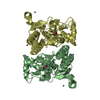

 Components
Components

 X-RAY DIFFRACTION / Number of used crystals: 1
X-RAY DIFFRACTION / Number of used crystals: 1  Sample preparation
Sample preparation SYNCHROTRON / Site:
SYNCHROTRON / Site:  CHESS
CHESS  / Beamline: A1 / Wavelength: 0.977 Å
/ Beamline: A1 / Wavelength: 0.977 Å Processing
Processing MOLECULAR REPLACEMENT
MOLECULAR REPLACEMENT Movie
Movie Controller
Controller


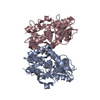



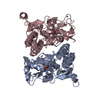
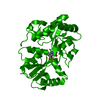
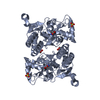
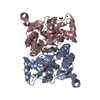



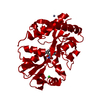
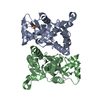
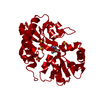

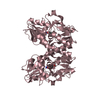

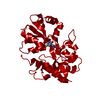
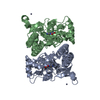
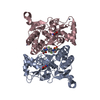
 PDBj
PDBj




